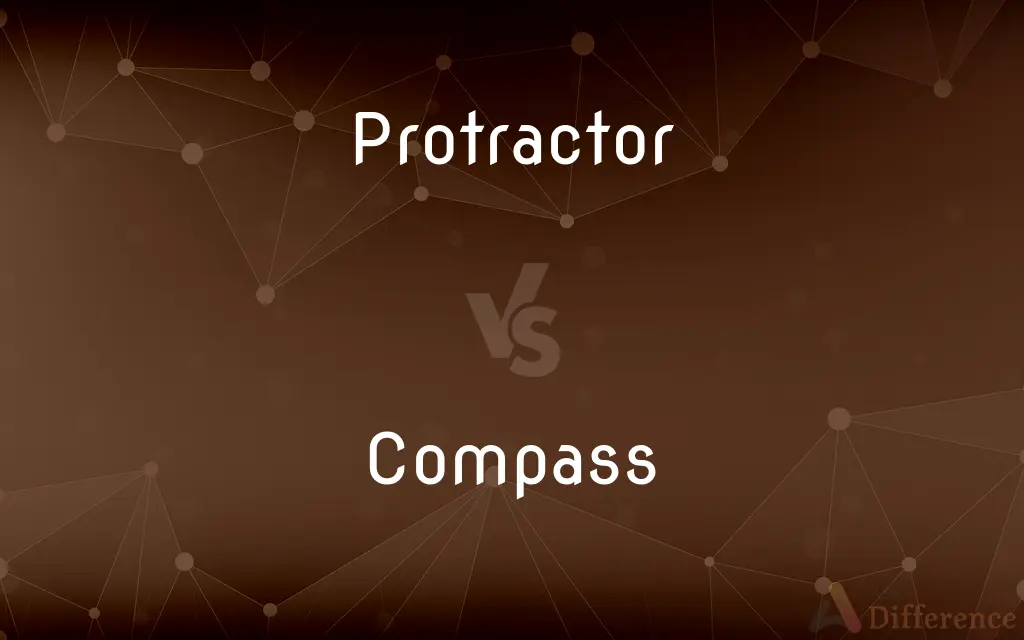Protractor vs. Compass — What's the Difference?
By Tayyaba Rehman & Fiza Rafique — Updated on May 3, 2024
Protractors measure angles in degrees, typically made of transparent plastic or glass; compasses are drafting tools used for drawing circles or arcs.

Difference Between Protractor and Compass
Table of Contents
ADVERTISEMENT
Key Differences
A protractor is primarily used for measuring angles, commonly found in educational settings where geometry is taught. On the other hand, a compass is used for drawing circles or arcs, crucial in both educational and professional drafting environments.
Protractors typically feature a semicircular design marked with degrees from 0 to 180. Whereas, compasses consist of two legs connected at a pivot; one leg has a point to anchor the tool, and the other holds a pencil to draw.
The material of a protractor is usually transparent plastic or glass to easily see the base lines and angles being measured. Conversely, compasses are often made of metal for stability and precision, with some high-end models also incorporating adjustment mechanisms for more accurate control.
While protractors provide static measurements of angles, compasses offer dynamic use, allowing the user to adjust the radius and create multiple sizes of circles or arcs based on the distance between the legs.
Protractors are often used in conjunction with rulers and straightedges to measure and draw precise angles. In contrast, compasses can be used independently to construct the needed geometric figures without additional tools.
ADVERTISEMENT
Comparison Chart
Primary Use
Measuring angles
Drawing circles or arcs
Design
Semicircular, marked in degrees
Two legs with a pivot, one leg with a pencil
Material
Transparent plastic or glass
Typically metal
Method of Use
Static measurement
Dynamic use with adjustable radius
Dependency on Tools
Used with rulers and straightedges
Can be used independently
Compare with Definitions
Protractor
Collaborates with other tools for accurate measurements.
She aligned her protractor with the straightedge to measure the angle precisely.
Compass
Often used in drafting and design.
The architect used a compass to sketch the initial design of the roundel.
Protractor
Usually semicircular in shape and marked in degrees.
Her protractor was made of clear plastic, making it easy to read the degrees.
Compass
A tool used for drawing circles or arcs.
He adjusted the compass to draw a perfect circle on the blueprint.
Protractor
Used in educational and engineering contexts.
In geometry class, everyone had a ruler and a protractor for the exercise.
Compass
Consists of two legs hinged together.
The compass legs adjusted smoothly, allowing for precise control of the radius.
Protractor
Often made of transparent material.
The transparency of the protractor helped him align it properly on the drawing.
Compass
One leg has a point, the other holds a drawing implement.
The pointed leg of the compass was anchored firmly on the paper.
Protractor
A tool used for measuring angles.
The student used a protractor to measure the angle of the triangle.
Compass
Provides dynamic measurements and constructions.
Adjusting the compass, she created several arcs for the design.
Protractor
A protractor is a measuring instrument, typically made of transparent plastic or glass, for measuring angles. Some protractors are simple half-discs or full circles.
Compass
A compass is a device that shows the cardinal directions used for navigation and geographic orientation. It commonly consists of a magnetized needle or other element, such as a compass card or compass rose, which can pivot to align itself with magnetic north.
Protractor
A semicircular instrument for measuring and constructing angles.
Compass
An instrument containing a magnetized pointer which shows the direction of magnetic north and bearings from it
Walkers should be equipped with a map and compass
A magnetic compass
Crewe was ideally placed on the rail network, with connections running to all points of the compass
Protractor
(Anatomy) A muscle that extends a limb or other part.
Compass
An instrument for drawing circles and arcs and measuring distances between points, consisting of two arms linked by a movable joint, one arm ending in a point and the other usually carrying a pencil or pen
A regular heptagon cannot be constructed accurately with only ruler and compass
Protractor
One who, or that which, protracts, or causes protraction.
Compass
The range or scope of something
The event had political repercussions which are beyond the compass of this book
Goods and services which fall within the compass of the free market
Protractor
A circular or semicircular tool for drawing or measuring angles.
Compass
Go round (something) in a circular course
The ship wherein Magellan compassed the world
Protractor
(surgery) An instrument formerly used in extracting foreign or offensive matter from a wound.
Compass
Contrive to accomplish (something)
He compassed his end only by the exercise of violence
Protractor
(anatomy) A muscle that extends an organ or part; opposed to retractor.
Compass
A device used to determine geographic direction, usually consisting of a magnetic needle or needles horizontally mounted or suspended and free to pivot until aligned with the earth's magnetic field.
Protractor
An adjustable pattern used by tailors.
Compass
Another device, such as a radio compass or a gyrocompass, used for determining geographic direction.
Protractor
One who, or that which, protracts, or causes protraction.
Compass
A V-shaped device for describing circles or circular arcs and for taking measurements, consisting of a pair of rigid, end-hinged legs, one of which is equipped with a pen, pencil, or other marker and the other with a sharp point providing a pivot about which the drawing leg is turned. Also called pair of compasses.
Protractor
A mathematical instrument for laying down and measuring angles on paper, used in drawing or in plotting. It is of various forms, semicircular, rectangular, or circular.
Compass
Awareness or understanding of one's purpose or objectives
"Lacking a coherent intellectual and moral commitment, [he] was forced to find his compass in personal experience" (Doris Kearns Goodwin).
Protractor
An instrument formerly used in extracting foreign or offensive matter from a wound.
Compass
An enclosing line or boundary; a circumference
Outside the compass of the fence.
Protractor
A muscle which extends an organ or part; - opposed to retractor.
Compass
A restricted space or area
Four huge crates within the compass of the elevator.
Protractor
An adjustable pattern used by tailors.
Compass
Range or scope, as of understanding, perception, or authority
The subject falls outside the compass of this study.
Protractor
Drafting instrument used to draw or measure angles
Compass
(Music) See range.
Compass
To make a circuit of; circle
The sailboat compassed the island.
Compass
To surround; encircle
The trees compass the grave.
Compass
To understand; comprehend
"God ... is too great a profundity to be compassed by human cerebration" (Flann O'Brian).
Compass
To accomplish or bring about
"He compassed his end only by the exercise of gentle violence" (Henry James).
Compass
To gain or achieve
"She had compassed the high felicity of seeing the two men beautifully take to each another" (Henry James).
Compass
To scheme; plot
Compass the death of the king.
Compass
Forming a curve.
Compass
A magnetic or electronic device used to determine the cardinal directions (usually magnetic or true north).
Compass
A pair of compasses (a device used to draw an arc or circle).
Compass
(music) The range of notes of a musical instrument or voice.
Compass
(obsolete) A space within limits; an area.
Compass
(obsolete) An enclosing limit; a boundary, a circumference.
Within the compass of an encircling wall
Compass
Moderate bounds, limits of truth; moderation; due limits; used with within.
Compass
(archaic) Scope.
Compass
(obsolete) Range, reach.
Compass
(obsolete) A passing round; circuit; circuitous course.
Compass
To surround; to encircle; to environ; to stretch round.
Compass
To go about or round entirely; to traverse.
Compass
(dated) To accomplish; to reach; to achieve; to obtain.
Compass
(dated) To plot; to scheme (against someone).
Compass
(obsolete) In a circuit; round about.
Compass
A passing round; circuit; circuitous course.
They fetched a compass of seven day's journey.
This day I breathed first; time is come round,And where I did begin, there shall I end;My life is run his compass.
Compass
An inclosing limit; boundary; circumference; as, within the compass of an encircling wall.
Compass
An inclosed space; an area; extent.
Their wisdom . . . lies in a very narrow compass.
Compass
Extent; reach; sweep; capacity; sphere; as, the compass of his eye; the compass of imagination.
The compass of his argument.
Compass
Moderate bounds, limits of truth; moderation; due limits; - used with within.
In two hundred years before (I speak within compass), no such commission had been executed.
Compass
The range of notes, or tones, within the capacity of a voice or instrument.
You would sound me from my lowest note to the top of my compass.
Compass
An instrument for determining directions upon the earth's surface by means of a magnetized bar or needle turning freely upon a pivot and pointing in a northerly and southerly direction.
He that first discovered the use of the compass did more for the supplying and increase of useful commodities than those who built workhouses.
Compass
A pair of compasses.
To fix one foot of their compass wherever they please.
Compass
A circle; a continent.
The tryne compas [the threefold world containing earth, sea, and heaven. Skeat.]
Its leaves are turned to the north as true as the magnet:This is the compass flower.
Compass
To go about or entirely round; to make the circuit of.
Ye shall compass the city seven times.
We the globe can compass soon.
Compass
To inclose on all sides; to surround; to encircle; to environ; to invest; to besiege; - used with about, round, around, and round about.
With terrors and with clamors compassed round.
Now all the blessingsOf a glad father compass thee about.
Thine enemies shall cast a trench about thee, and compass thee round.
Compass
To reach round; to circumvent; to get within one's power; to obtain; to accomplish.
If I can check my erring love, I will:If not, to compass her I'll use my skill.
How can you hope to compass your designs?
Compass
To curve; to bend into a circular form.
Compass
To purpose; to intend; to imagine; to plot.
Compassing and imagining the death of the king are synonymous terms; compassing signifying the purpose or design of the mind or will, and not, as in common speech, the carrying such design to effect.
Compass
Navigational instrument for finding directions
Compass
An area in which something acts or operates or has power or control:
The range of a supersonic jet
The ambit of municipal legislation
Within the compass of this article
Within the scope of an investigation
Outside the reach of the law
In the political orbit of a world power
Compass
The limit of capability;
Within the compass of education
Compass
Drafting instrument used for drawing circles
Compass
Bring about; accomplish;
This writer attempts more than his talents can compass
Compass
Travel around, either by plane or ship;
We compassed the earth
Compass
Get the meaning of something;
Do you comprehend the meaning of this letter?
Common Curiosities
What materials are compasses typically made of?
Compasses are typically made of metal for durability and precision.
How do you use a protractor to measure an angle?
Align the baseline of the protractor with one leg of the angle and read the degree measurement where the other leg intersects the protractor.
What is the main use of a compass?
A compass is primarily used to draw circles or arcs.
Are there different types of protractors?
Yes, there are full-circle protractors and semicircular protractors.
Can a protractor measure full circles?
No, a typical protractor measures up to 180 degrees, half a circle.
How does a compass work?
A compass works by adjusting the distance between its legs to change the radius of the circle or arc being drawn.
What is the main use of a protractor?
A protractor is primarily used to measure angles in degrees.
Are there different types of compasses?
Yes, there are simple compasses for basic use and precision compasses with fine adjustments.
Is a protractor used in professional settings?
Yes, protractors are used in various professional fields, including engineering and architecture.
Can a compass be used without other tools?
Yes, a compass can be used independently to draw circles and arcs.
Can a protractor measure angles greater than 180 degrees?
Some specialized protractors can measure angles greater than 180 degrees, but typical ones cannot.
What are the educational applications of a protractor and a compass?
Both tools are extensively used in geometry classes to teach about angles, circles, and other geometric concepts.
What ensures the precision of a compass?
The quality of the hinge and the stability of the pivot point ensure precision.
What is the importance of the transparency of a protractor?
The transparency allows for better visibility and accurate alignment over the base lines.
How do I adjust a compass for different circle sizes?
Adjust the distance between the legs of the compass to change the radius of the circle.
Share Your Discovery

Previous Comparison
Haulier vs. Carrier
Next Comparison
Carpentry vs. MillworkAuthor Spotlight
Written by
Tayyaba RehmanTayyaba Rehman is a distinguished writer, currently serving as a primary contributor to askdifference.com. As a researcher in semantics and etymology, Tayyaba's passion for the complexity of languages and their distinctions has found a perfect home on the platform. Tayyaba delves into the intricacies of language, distinguishing between commonly confused words and phrases, thereby providing clarity for readers worldwide.
Co-written by
Fiza RafiqueFiza Rafique is a skilled content writer at AskDifference.com, where she meticulously refines and enhances written pieces. Drawing from her vast editorial expertise, Fiza ensures clarity, accuracy, and precision in every article. Passionate about language, she continually seeks to elevate the quality of content for readers worldwide.













































